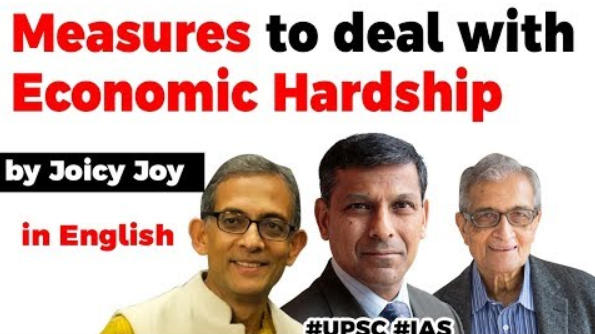Table of Contents
- Recently, prominent economists Amartya Sen, Raghuram Rajan and Abhijit Banerjee have raised concerns
- Also suggested measures to deal with economic hardships created by the Covid-19 lockdown.
DETAILS
- Risk of Defiance of Lockdown Orders:
- In the scenario of extended lockdown, a huge number of people will be pushed into dire poverty or even starvation by the combination of the loss of their livelihoods and interruptions in the standard delivery mechanisms.
- This opens up the risk of large-scale defiance of lockdown orders.
- Reassurance to People: The government needs to reassure people that it does care and their minimum well-being will be secure.
- Moreover, the government has the resources to do this.
- The stocks of food at the Food Corporation of India stood at 77 million tons in March 2020, more than three times the “buffer stock norms”. This is also likely to grow over the next few weeks as the Rabi crop comes in.
- Extend PDS Beyond 3 Months: Although the government has offered a supplementary Public Distribution System (PDS) provision of 5 kg/person/month for the coming three months.
- However, it is likely that three months will not be enough, since even if the lockdown ends soon, the process of reopening the economy will take time.
- Multidimensional Challenges: The starvation is just one of the worries, the unexpected loss of income and savings can have serious consequences. E.g.
- Farmers need money to buy seeds and fertilizer for the next planting season.
- Shopkeepers need to fill their shelves again.
- Many others have to repay the loan that is already due.
- Improvement Needed:
- The government has partly recognized this in the cash transfers it has promised to certain groups under Pradhan Mantri Garib Kalyan Package
- Amounts are both small and narrowly targeted.
Food Corporation of India (FCI)
- Public Sector Undertaking
- Under the Ministry of Consumer Affairs, Food and Public Distribution.
- Established as a statutory body in 1965 under the Food Corporations Act 1964.
- Established against the backdrop of a major shortage of grains, especially wheat.
Public distribution system (PDS)
- The PDS is an Indian food Security System established under the Ministry of Consumer Affairs, Food and Public Distribution.
- PDS evolved as a system of management of scarcity through distribution of food grains at affordable prices.
- Under the PDS, presently the commodities namely wheat, rice, sugar and kerosene are being allocated to the States/UTs for distribution. Some States/UTs also distribute additional items of mass consumption through the PDS outlets such as pulses, edible oils, iodized salt, spices, etc.
- PDS is operated under the joint responsibility of the Central and the State Governments.
- The Central Government, through Food Corporation of India (FCI), has assumed the responsibility for procurement, storage, transportation and bulk allocation of food grains to the State Governments.
- The operational responsibilities including allocation within the State, identification of eligible families, issue of Ration Cards and supervision of the functioning of Fair Price Shops (FPSs) etc., rest with the State Governments.
Issues Involved
- Exclusionary PDS: A substantial fraction (over 10 crore) of the poor are excluded from the PDS rolls, for one reason or another and the supplementary provision only applies to those who are already on it.
- The exclusion in the Public Distribution System is because of outdated 2011 census data being used to calculate State-wise National Food Security Act (NFSA) coverage.
- Under the NFSA, the PDS is supposed to cover 75% of the population in rural areas and 50% of the population in urban areas, which works out to 67% of the total population, using the rural-urban population ratio in 2011.
- India’s population was about 121 crore in 2011 and so PDS covered approximately 80 crore people. However, applying the 67% ratio to a projected population of 137 crore for 2020, PDS coverage today should be around 92 crore.
- Issue of Pending Applications: Many State governments are reluctant to issue new ration cards beyond the numbers that will be provided for by the Central quota.
- For example, there are about seven lakh pending applications for ration cards in Jharkhand, because the State government stopped issuing new ration cards several years ago to avoid exceeding the numbers provided for by the Central government.
WAY AHEAD
- Giving away some of the existing stock
- Expanding the PDS.
- Setting up public canteens for migrants and others who are away from home.
- Sending the equivalent of the school meal to the homes of the children
- Making use of reputed local NGOs that often have a reach among the most marginalized
- Cash transfer through PMJDY.
- Issuing temporary ration cards — perhaps for six months — with minimal checks to everyone who wants ration cards.
Latest Burning Issues | Free PDF






















 WhatsApp
WhatsApp